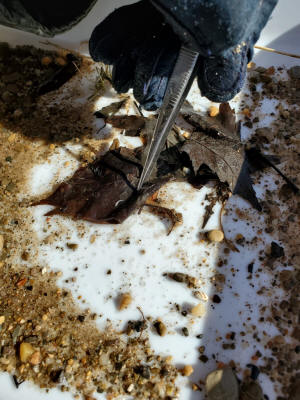|
 As the
RiverWatch website says, “The Illinois RiverWatch safeguards the
future of Illinois rivers and streams through stewardship, education
and sound science.” As the
RiverWatch website says, “The Illinois RiverWatch safeguards the
future of Illinois rivers and streams through stewardship, education
and sound science.”
The training was led by Stream Ecologist and RiverWatch Director
Danelle Haake, who trains citizen scientists how to monitor stream
habitats and water quality.
The citizen scientists do the monitoring through habitat and
biological surveys where they collect and identify small stream
organisms, known as macroinvertebrates or aquatic invertebrates.
Using data on the types and amounts of these organisms helps citizen
scientists calculate the quality of a stream.
Those in attendance were Leslie, Mike and Stephen Starasta, Julie
and Laney Saylor and Pam Moriearty. Leslie Starasta has done past
RiverWatch trainings and served as a Citizen Scientist, but said she
wanted to take this training as a refresher course. Moriearty has
been monitoring Sugar Creek and logging data since 2014.
Dr. Dennis Campbell was on hand to assist with activities as needed.
He said Sugar Creek has more species in it than any other mid-level
stream in Illinois.


Julie Saylor
examining critters through a mictoscope
Attendees spent the morning at Lincoln College where
they learned about various macroinvertebrates. After learning about
these macroinvertebrates, attendees were able to view samples from a
kit through a microscope. These samples included flatworms, aquatic
sowbugs, leeches, flatworms, scuds, and midges.
The afternoon was then spent at Lincoln College’s Dr. G. Dennis
Campbell Creekside Outdoor Center for Environmental Education (Creekside)
along Sugar Creek where everyone received hands-on instruction on
field techniques for creek monitoring.
RiverWatch volunteers have been monitoring Sugar Creek for several
years and RiverWatch recently named Creekside its 2021 Partner of
the Year. A January 28, 2022, Lincoln Daily News article said, “In
its selection of Creekside for this award, the Illinois RiverWatch
Network noted that Creekside has supported volunteers conducting
annual RiverWatch surveys, sponsored RiverWatch activities with
Master Naturalist volunteers and 4-H youth groups, and participated
in public communication efforts about research findings. Creekside
has also organized public Earth Day celebrations and nature
festivals that promote RiverWatch priorities within the local
agricultural community.”

In the afternoon activities, part of the training consisted of
putting a little ball in the stream to measure the flow and
distance. By taking the feet per second and dividing it by the
amount of time it takes the ball to float so many feet, one can
measure the flow of the water.
Participants were also shown how to monitor five different habitats:
riffles, leaf pack, snag, jab and sediment.
Haake trained everyone to collect the aquatic invertebrates from
these habitats and identify what they find. The volunteer scientists
then record the data, which helps them calculate stream quality
using what is called a Macroinvertebrate Biotic Index.
Haake explained and demonstrated various methods for collecting
samples from different habitats. She then had volunteers collect
samples from a riffle (shallow area) and leaf pack (clump of
leaves).

Stephen Starasta and
Danelle Haake collecting samples from a riffle
To collect samples from the riffle, a “netter” places
the net against the bottom of the streambed. A second person, called
a “kicker,” then picks up large rocks and rubs them around to get
the “aquatic invertebrates” off the rock. Next, the “kicker” will
shuffle and kick their feet from side to side to get the “aquatic
invertebrates” off the smaller rocks. Finally, the “netter” must
push the net upstream out of the water and put any aquatic
invertebrates caught into a bucket.

[to top of second column] |


Pam Moriearty and
Leslie Starsta collecting samples from a leaf pack
For the leaf pack, the “netter” holds the net
downstream of the leaf pack and the “kicker” grabs part of the
leaf pack and shakes it in front of the open net, dislodging the
aquatic invertebrates and letting the flow carry them into the
net. Some leaves from the leaf pack are also added to the net.
Ideally, they do not put the whole leaf pack in the net because
that might make the sorting process take a very long time as the
volunteers look on both sides of each leaf. These leaves and
aquatic invertebrates in the net are added to the same bucket as
the others.
Haake also explained how to sort what has been collected.
After samples are collected, volunteers pull handfuls at a time
of the contents of the bucket (including leaves, twigs, rocks,
silt, and invertebrates) and sort it in a pan of water. Any
material with a large surface should be examined to find any
aquatic invertebrates that might be attached. All the
invertebrates found should be put in the pan with the grid. Once
the larger material and hiding places are gone, any
invertebrates remaining in the pan should be found and
transferred to the gridded pan.

Once most of the solid material has been removed from the
bucket, the remaining material (mostly water and small
sediments) can be poured through the net. Rinse the bucket and
pour the rinse water through the net until the bucket is clean.
Then check the inside of the net for invertebrates and transfer
those found to the gridded pan.
If there are 100 invertebrates or less in the gridded pan, all
the invertebrates are put in a collection jar containing rubbing
alcohol.

Gridded pan for
sorting aquatic invertebrates
If there are more than 100, volunteers can opt to
subsample their collected invertebrates using the numbers of the
grid. The volunteer must select a number from the random number
cup provided with the kit, then place all the invertebrates in
the square with that number into the collection jar, counting as
they go. This process is repeated until at least 100
invertebrates are collected.

If there are any types of invertebrates that were not collected
as part of the subsampling, one of each type should be taken and
added to the collection jar. If the invertebrates are moving
quickly in the gridded pan, adding a few capfuls of soda water
to the pan slows them down.

Aquatic
invertebrates found on a leaf
In the samples collected Saturday, there were not
many aquatic macroinverte-brates. However, in their samples, the
participants were able to see sowbugs and midge worms.
Once RiverWatchers (citizen scientists) have been trained, they
can adopt a stream location to monitor and conduct habitat and
biological surveys. The primary monitoring period is May and
June. The citizen scientists then send to the RiverWatch office
to ensure the data collected is high quality.
[Angela Reiners] |